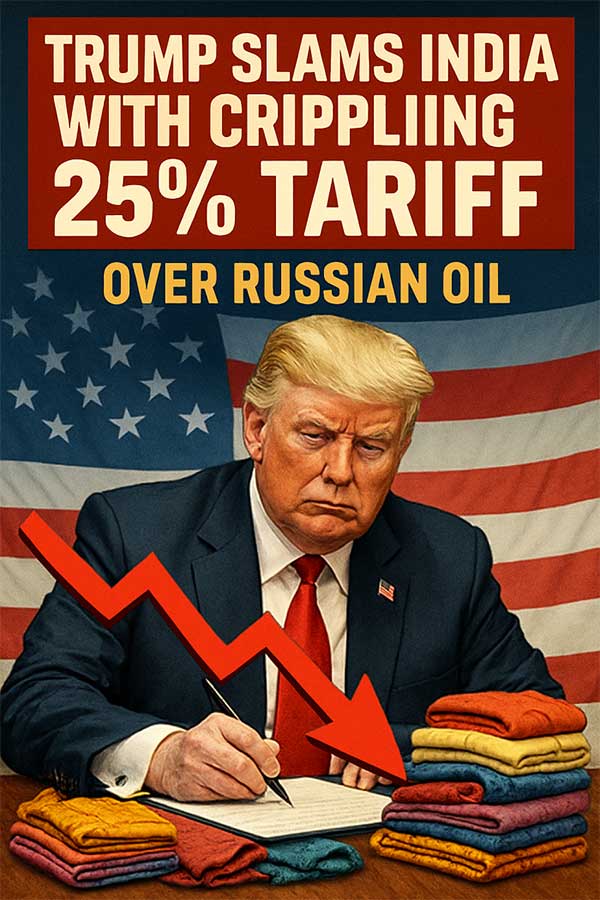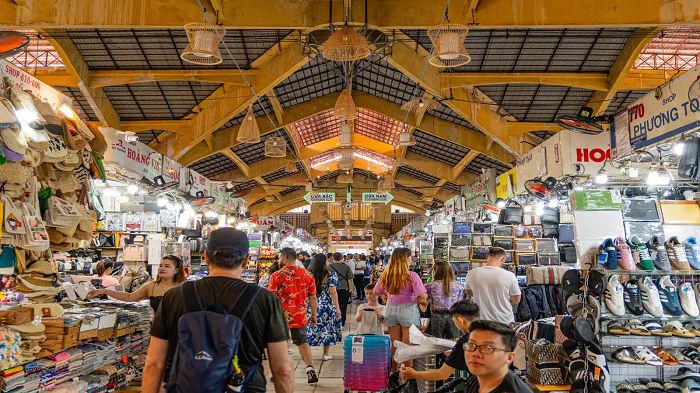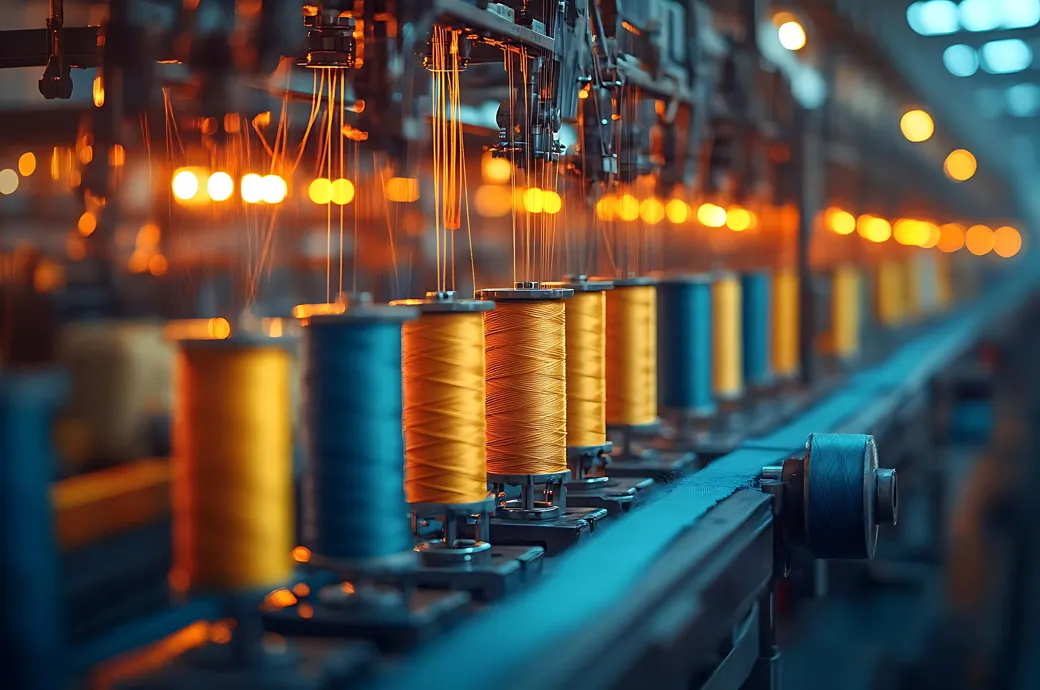FW
The second collaborative collection by Levi’s and ERL features a range of reimagined denim pieces infused with ERL's nostalgic, playful style. Inspired by the skate and surf culture of Venice, Calif, the capsule collection merges Levi’s iconic denim designs with a retro flair.
The collection includes a bootcut jean, vest, overall, dress, and purse, all adorned with various light washes that evoke a sun-faded aesthetic. Each piece showcases co-branded accents and distinctive stitching.
Taking cues from a vintage '70s Levi’s silhouette, the vest is treated to a washed-out effect and triple-lined with a shaggy sherpa finish at the hem. Featuring burnished tin shanks, zigzag stitching along the back and side seams, and ERL embroidery on the front panel, the vest exudes a unique charm.
The dress features a row of shanks down the front, complemented by a straight hem, zigzag stitching at the side seams, and convenient inseam pockets, with the ERL logo stamped at the bottom.
With a wide, baggy leg adorned with pintuck side striping, the overall offers a simplified design, omitting the front pocket and featuring tonal zigzag stitching along the center seam. ERL embroidery accents the left leg, while a hammer loop adorns the right.
Blending ERL’s relaxed fit with Levi’s classic 517 style, the bootcut jean boasts side seam slits for a subtle flare. Distressed detailing along the waistband and a white-printed Two-Horse Pull graphic add a contemporary touch.
Crafted with co-branded shanks, the purse mimics the design of a traditional 5-pocket jean, offering a unique accessory option.
This collaboration marks Levi’s second venture with ERL founder Eli Russell Linnetz, following their successful debut last fall. Photographed by Linnetz himself, the latest collection encapsulates the sun-kissed essence of Californian Americana. It is available through Levi.com, the Levi’s app, select Levi’s stores, and Dover Street Market.
Esteemed New York City-based brand celebrated by luminaries like Oprah, Beyoncé, and Selena Gomez, Telfar has launched a new collection titled, ‘Telfar Denim.’
Dubbed a ‘modular denim system,’ the collection includes a range of unisex garments, including jeans, shorts, skirts, and jackets. Each piece is meticulously crafted with unique features, such as three-panel segmentations, frayed cutout thighs, and deep pockets, ensuring both style and functionality. Custom hardware and debossed leather patches add a touch of luxury to the collection.
One of the collection's standout features is its commitment to inclusivity. Telfar spent over two years perfecting the unisex fit, leveraging its TeflarTV platform to fit the garments on hundreds of diverse bodies. This dedication to diversity ensures that the collection is accessible to a wide range of individuals, with sizes ranging from 2XS to 2XL.
Moreover, Telfar is disrupting the traditional fashion calendar by eschewing the typical showroom system. Instead, the brand is ‘building a wardrobe block by block,’ emphasising longevity over fleeting trends. This approach reflects Telfar's vision to re-center apparel on its own terms and challenge industry norms.
Sustainability is also a key focus for Telfar. The collection features cotton and organic cotton denim in black and indigo washes, sourced responsibly to minimize environmental impact. By prioritising sustainable materials and manufacturing processes, Telfar ensures that its garments are not only stylish but also eco-conscious.
In terms of accessibility, Telfar is making strides to ensure that the collection is available to a wider community. By securing the right manufacturing and materials, the brand aims to cater to more than just seasonal shoppers, fostering a more inclusive and sustainable fashion landscape.
Telfar Denim is now available on the brand's website, with prices ranging from $110 to $240. With its innovative design, commitment to inclusivity, and sustainable practices, this collection solidifies Telfar's position as a trailblazer in the fashion world.
Vardhman has approved an ambitious plan to revamp and modernise its spinning and fabric business with an investment of approximately Rs 2,000 crore. The plan signifies the company's commitment to expand its operational capacity while embracing sustainability.
Currently, Vardhman has a capacity of 12.37 lakh equivalent spindles and an annual production of around 175 million meters of processed fabric. As part of its expansion strategy, the company plans to add approximately 50,000 equivalent spindles including 5,520 rotors and 17,000 spindles. Additionally, Vardhman aims to venture into the Technical Textiles sector and produce approximately 15 lakh meters of fabric per month.
In line with its commitment to sustainable practices, Vardhman is set to venture into Green Power generation, exploring avenues such as solar, wind, or hybrid projects. This move echoes the company's dedication to reduce its carbon footprint and embrace renewable energy sources. Furthermore, Vardhman aims to upgrade its IT systems to streamline operations and boost efficiency.
The ambitious expansion and modernisation plan is slated to be executed within the next two years. The project will help Vardhman unlock new business synergies and secure a competitive edge in the market. Additionally, these modernisation efforts will enable Vardhaman to drive productivity gains across various business operations.
Compared to the previous year, China's textile and apparel (T&A) exports declined by 3.12 per cent Y-o-Y to $23.934 billion in April 2024. Data from Chinese Customs shows, China’s textile exports declined by 2.36 per cent Y-o-Y to $12.190 billion, while garment exports decreased by 3.90 per cent Y-o-Y to $11.744 billion.
In the first four months of 2024, the value of China’s cumulative exports of textiles and clothing registered a modest increase of 0.58 per cent Y-o-Y to $89.836 billion over the same period in the previous year. Textile exports from January to April increased by 1.19 per cent Y-o-Y to to $44.28 billion compared to the corresponding months in 2023. Meanwhile, apparel exports remained steady at $45.55 billion during the same timeframe.
The fluctuations in export figures reflect the dynamic nature of the global textile and apparel market and underscore the need for continuous adaptation and innovation within China's textile industry to maintain its competitiveness on the international stage.
In Q1, FY’24, apparel imports by the US dropped by 7.14 per cent to 18.07 billion from 19.46 billion in the corresponding quarter of the previous year.
As per data from the Office of Textiles and Apparel (OTEXA), apparel imports by the US from Bangladesh declined by 17 per cent to $1.75 billion from $2.13 billion during Q1FY23, indicating a significant shift in sourcing preferences or market conditions.
Contrastingly, apparel imports from China, another heavyweight in apparel manufacturing, registred a marginal dip of only 0.71 per cent, reinstating China's dominance as the one of the major apparel supplier to the US.
Emerging as formidable competitor in the apparel industry, Vietnam recorded a modest increase of 0.91 cent in clothing exports to the US. This uptick signifies a growing reliance on Vietnam as a sourcing destination due to factors such as competitive pricing or manufacturing capabilities.
Similarly, Cambodia witnessed a notable surge of 11.13 per cent in clothing exports to the US. This trend was possibly driven by factors like favorable trade agreements or operational efficiencies within the Cambodian garment industry.
Conversely, US clothing imports from India declined by 8.79 per cent, indicating a potential challenge or shift in competitiveness within the Indian apparel sector vis-à-vis other sourcing destinations.
Overall, these fluctuations in apparel imports underscore the intricate dynamics of global trade relationships and the constant evolution of sourcing strategies within the highly competitive apparel industry.
Vardhaman Textiles unveiled its fourth-quarter financial results on May 9, 2024, showcasing resilience amidst market turbulence. Despite a slight dip in topline performance by 1.05 per cent year-over-year (YoY), the company witnessed a robust 26.36 per cent increase in profits. Quarter-on-quarter (QoQ) comparisons revealed a notable upswing, with revenue climbing by 5.58 per cent and profits surging by 25.19 per cent.
A closer look at operational metrics unveils a strategic tightening of expenses. Selling, general, and administrative expenses saw a significant 8.89 per cent decline sequentially, juxtaposed with a 7.1 per cent YoY uptick. Operating income surged impressively by 45.99 per cent QoQ and 33.74 per cent YoY, underlining the company's adept management amidst challenging economic conditions.
Earnings per share (EPS) stood at Rs 7.05 for Q4, marking a substantial 26.43 per cent YoY increase, reflecting positively on the company's bottom line growth trajectory.
Despite recent market volatility, Vardhaman Textiles has exhibited resilience in its returns, with a -3.07 per cent performance over the past week, while boasting a robust 14.71 per cent return over the last six months and a 10.54 per cent Year-to-Date (YTD) return.
Analyst sentiments remain predominantly bullish, with a consensus "Buy" recommendation as of May 11, 2024. Out of four analysts covering the company, two issued a "Strong Buy" rating, one a "Buy" rating, and one a "Sell" rating.
With a market capitalization of Rs 12343.43 Cr and a 52-week high/low of
Rs 475.5 & Rs 318.35 respectively, Vardhaman Textiles continues to navigate market challenges with a solid financial footing, positioning itself for sustained growth in the textile sector.
Indorama Ventures Public Company Limited (IVL), a leading global sustainable chemical producer, showcased a robust quarterly performance with a 32 per cent increase in Adjusted EBITDA1 (earnings before interest, taxes, depreciation, and amortization) to $366 million in 1Q24, signaling a positive shift amidst the prolonged destocking trend. Despite a 2 per cent YoY decline, the company's strategic advancements under its IVL 2.0 evolved strategy demonstrated resilience in navigating challenging market dynamics.
The quarter witnessed a 3 per cent QoQ growth in sales volume, indicating a gradual recovery across all sectors as customer destocking abated, although a US winter freeze posed a temporary setback. Lower utilities costs in Europe, supply chain optimizations, and favorable shale gas economics in the U.S. bolstered profitability.
While the recovery momentum is expected to persist through 2024, challenges loom due to industry-wide capacity surpluses, inflation, and high interest rates, particularly impacting the polyester value chain. However, IVL remains optimistic, with its HVA segment poised for a healthy 2024 post-destocking.
Under its IVL 2.0 plan, the company focuses on asset optimization, debt reduction, and cash flow generation to enhance shareholder value. Leveraging SAPS/4HANA ERP and AI tools, IVL aims to drive productivity and cost efficiencies while modernizing operations.
In line with its strategic objectives, IVL is optimizing sites and refinancing debt, ensuring ample liquidity. Additionally, preparations for IPOs of its packaging and surfactants businesses signify efforts to unlock further value.
Segment performances reflected the company's resilience, with CPET and Fibers segments posting notable gains amidst supply chain disruptions and demand recoveries.
Aloke Lohia, Group CEO of Indorama Ventures, expressed confidence in the company's trajectory, emphasizing a commitment to cost management and competitiveness as they navigate evolving market conditions.
The fabrics market is poised for robust growth, with projections indicating a surge from $116.67 billion in 2023 to $123.42 billion in 2024, and a further climb to $148.78 billion by 2028, according to ResearchAndMarkets. A compound annual growth rate (CAGR) of 5.8 per cent is anticipated for the immediate future, driven by factors such as economic dynamism in emerging markets and the burgeoning automotive industry.
These trends are supplemented by a heightened demand for man-made fibers. Looking ahead, the market is expected to witness a steady ascent, with a CAGR of 4.8 per cent through 2028, attributed to the rise of e-commerce, burgeoning sportswear demand, population growth, and technological advancements.
Key emerging trends include the adoption of blockchain, digital textile printing, and the development of smart fabrics. Additionally, the integration of robotics and artificial intelligence in manufacturing processes underscores a shift towards advanced production methodologies. Notably, the fabrics manufacturing market stands to benefit from the surge in online shopping, enabling manufacturers to expand their reach globally.
Furthermore, the demand for home furnishing fabrics is expected to soar, propelled by consumer preferences for personalized decor. Market players are strategically focusing on natural fabrics to bolster their product offerings. Asia-Pacific leads the market, followed by Western Europe, with a comprehensive global market analysis covering key regions including North America, South America, Middle East, and Africa.
The rapid adoption of smart fabrics across diverse sectors, ranging from fashion to healthcare, signifies a transformative shift in textile technology. These fabrics, capable of interacting with their environment, offer a spectrum of applications from medical diagnostics to performance monitoring in sports. Major companies are investing in natural fabric innovations, signaling a paradigm shift towards sustainable and eco-friendly textile solutions.
Milan's Centro Congressi Fondazione Cariplo is set to become the epicenter of sustainable fashion innovation on May 14th and 15th as it hosts the fourth edition of CTF-Challenge The Fabric. Organized by Ekman & Co and the Swedish Fashion Council (SFC), the event aims to unite stakeholders across the supply chain of man-made cellulosic fibers (MMCF), including industry leaders from fashion, textiles, and forestry.
MMCFs, derived from sources like wood and agricultural waste, are gaining prominence for their regenerative properties. With sustainability at the forefront, CTF 2024 emphasizes the importance of responsibly sourced cellulose and eco-friendly manufacturing processes.
This year's event reintroduces the CTF Award, spotlighting designers who harness MMCF materials. Among the speakers are representatives from industry giants like Birla, Kering Group, and Puma Sodra, alongside emerging talents like Forbes-listed Paolina Russo.
Russo's debut capsule collection, featuring Spinnova—a sustainable, mechanically produced fiber—challenges perceptions of vibrant, eco-conscious fashion. The collection, comprising a mini skirt, oversize jacket, and jeans, showcases the creative potential of bio-based materials.
As part of the Challenge the Fabric Award, designers are encouraged to embrace MMCFs and explore alternatives to traditional fabrics. With a full-day symposium facilitating dialogue and action, CTF 2024 is poised to drive meaningful change in the fashion industry's sustainability landscape.

The U.S. Department of Agriculture (USDA) released its May World Agricultural Supply and Demand Estimates (WASDE) report on May 10th, 2024, providing insights into the future of cotton production and consumption. The report offers a more optimistic outlook for the 2024/25 season compared to the previous year.
U.S. production poised for increase
The May WASDE report projects a significant increase in U.S. cotton production for the upcoming season. Here's a breakdown of the key data points:
|
Factor |
2023/24 (Actual/Estimate) |
2024/25 (Forecast) |
Change |
|
Planted Area (million acres) |
Not Applicable |
10.67 |
N/A |
|
Harvested Area (million acres) |
6.4 |
9.1 |
+2.7 |
|
Production (million bales) |
12.1 |
16 |
+3.9 |
The projected increase in production is attributed to a rise in planted area and lower abandonment rates compared to 2023/24. This is welcome news for cotton producers who have faced challenges in recent seasons.
Global cotton trends
The May WASDE report also forecasts a global increase in cotton production and consumption in 2024/25. Here's a glimpse into the global projections:
|
Factor(million bales) |
2023/24 (Estimate) |
2024/25 (Forecast) |
Change |
|
Production |
120 |
125.4 |
+5.4 |
|
Consumption |
118 |
121.5 |
+3.5 |
|
Ending Stocks |
80.5 |
83 |
+2.5 |
The larger global production is expected to be driven by increased plantings and yields in major cotton-producing countries like Brazil, Turkey, and the United States. However, this growth is likely to outpace consumption, leading to a projected rise in ending stocks.
Market implications
The May WASDE report's projections for increased cotton production could put downward pressure on cotton prices in the upcoming season. However, the overall supply and demand situation remains dynamic and will be influenced by various factors, including global economic conditions and trade policies.
Looking ahead
The USDA's WASDE report serves as a valuable tool for cotton industry stakeholders to make informed decisions. While the May report offers a positive outlook for production, it's crucial to monitor future WASDE reports and other market indicators to stay updated on the evolving cotton market landscape.












